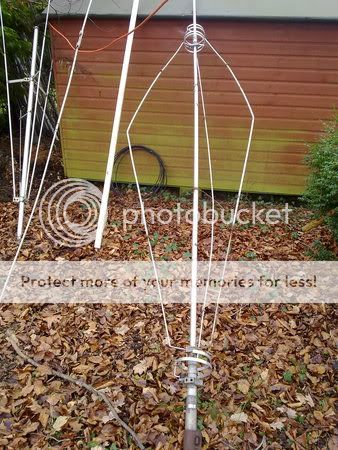Wow, I'm not only feeling baffled, :blink: - I'm dazzled! ...CDX, if you agree that adding one radial increases gain slightly, then you must connect that with the fact the additional radial combines in the far field. Therefore it is not true that only a radial facing the direction of signal will increase the signal.
With respect to the "bloom" we've gone over this before. It is in "full bloom" as you put it. I have not guessed at this. I've asked the question to the right person and at this point I even have the complete CST video version to confirm it. It shows exactly what I said. The field collapsing in on itself and reforming the same peak in the opposite phase.
To me it's self explanatory where this antenna get's it gain from. We have about 27 feet of in phase radiation surface area. It contains two independent current nodes. The CST image is as near field as it gets and does not show the combined effect of the four radials.
If you think it's possible for the bottom 1/4 wave to reach it's "full bloom" point at any other phase angle then the top 1/2 wave, you're not understanding this has nothing to do with antenna design and everything to do with the RF source.
The source is a sign wave. As with any sign wave there will be two phase angles where there is no energy into the load (0 degrees and 180 degrees) and two phase angles with maximum energy (90 degrees and 270 degrees). The Vector image is for sure shown with the source applying energy at the 90 degree phase angle.

...some nice long responses but still no explanation for why the Vector CST model shows so little energy in one area compared to another, other than the obvious. Thank you Mr CST for showing us what's really going on.
For the lower ¼λ cone to operate in a non-apparent collinear fashion it would have to radiate as efficiently as the upper ½λ. If this were so, it would then show a current bloom equally as wide but only ½ as long.
It doesn't.
I believe I've now seen, and read, enough evidence for me to side with the 'negligible' radiation camp, (as per the patent explanation) accepting the entire antenna as radiating including the lower ¼λ cone, but only enough from the lower ¼λ cone to cancel the undesirable out of phase main element current, (as shown in the CST model) lowering the TOA as it elevates the upper ½λ.
Apparently the Vector is achieving a lower TOA over a conventional end-fed 5/8λ, providing the associated far-field gain but merely equaling the SGM, not providing enough gain to be a true fully radiating collinear, which is typically closer to 2-3 S-units far-field gain, a perceived gain figure I and others have witnessed on multiple occasions from the introduction of a collinear element and which I simply won't waste time debating.
...and I'd like to see that full Vector CST.
Movin' on...






